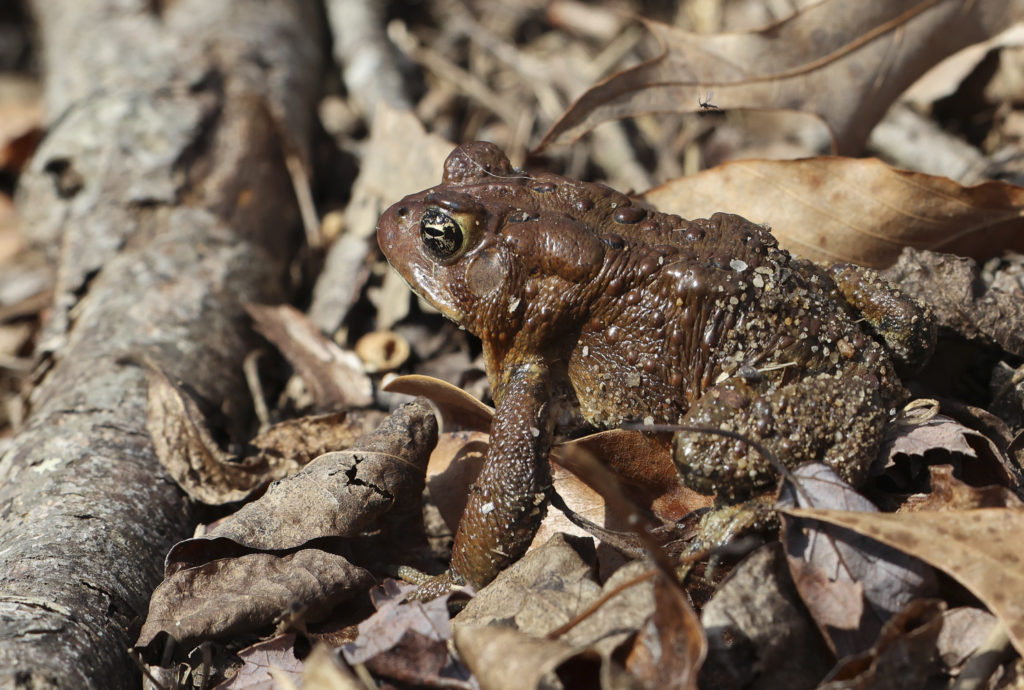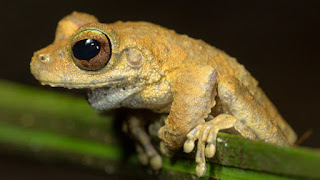Creature Feature - Bay Weekly

Spring Toads on the Move
By Wayne Bierbaum
As I write this, the sound of spring peepers chirping is filling the warm spring air. They are singing loudly and don't seem to want to quiet down. This morning, I met another Maryland amphibian, an American toad.
Spring is the time for the frogs and salamanders to escape their winter hiding places and pursue breeding. Spring peepers awaken from winter around the pond or lake where they live, but amphibians like salamanders and toads that frequently spend the winter away from their breeding areas have to travel over land to vernal pools or rivers and lakes for mating season.
The toad that I saw was hopping through leaf litter near the Patuxent River. I wonder how far it had traveled to get there. The Virginia Herpetological Society reports that American toads will, on average, travel 250 yards for reproduction but some appear to travel up to 1,000 yards.
The males, who are smaller than the females, first appear at the breeding areas a week or so before the females. A competition starts as males start calling out to the females. When they arrive, the females seem to choose a mate according to how well they can sing. The amorous pairs will spend several hours together and as the females lay eggs the male fertilizes them externally.
The tadpoles that subsequently hatch are omnivores and feed on everything from decaying plants to insects. They are known to cluster together for protection. They have a long tail for swimming but as the tadpole matures the tail becomes cannibalized and reabsorbed, but the end of the tail can also be sacrificed to a predator to save the tadpole's life.
As the tiny toad leaves the water it is frequently part of a mass of tiny hopping animals leaving together for protection. I have witnessed so many tiny toads crossing a path that I could not keep walking.
The developing toads are at risk of being eaten by snakes, especially hognose snakes, birds, and mammals. However, the toads have several other defenses besides massing. They have mildly toxic wart-like glands that cover most of their body. The glands express a gooey noxious substance with pressure or when the toad tightens its skin. Toads also are mostly nocturnal and spend daylight hidden under rocks, logs or shallow holes that they dig out with their hind legs.
American toads can live to be 5 years old and become sexually active in two years. They are found around the U.S. but are at their highest concentration in the Northeast. They are the most common toad found in forests and the edge of fields. These toads easily accommodate to living around humans and can be seen feeding on insects attracted to lights at night and are nicknamed "yard toads". Their favorite food seems to be beetles.
Besides the American toad, there are two other species of toads found in Maryland. The Fowler's toad is more common in sandy areas and fields. They resemble American toads but have parallel dark markings along their back and sides whereas the American toad will have a single pale line down its back. Fowler's toad is an eastern U.S. species.
Another species of toad found in Maryland is the spade-foot toad. They spend most of their lives buried in the ground. They are small, less than two inches, and are narrower than the other toads. They have two yellow stripes down their back and they have only tiny warts. They live in wooded areas in the southeastern U.S. and occasionally can be found above ground on a humid night or after a hard rain.
All amphibians absorb water through their skin and therefore are very sensitive to chemicals/poisons in their environment. Lawn chemicals frequently kill American toads. Reducing or stopping the use of these products will help the amphibians and the Bay.
Because of their noxious glands, they do not make good pets—Maryland requires a permit to keep any wild animal as a pet. It is best to keep dogs and cats away from them as their toxins can cause seizures if swallowed.



Comments
Post a Comment